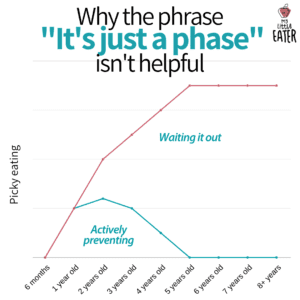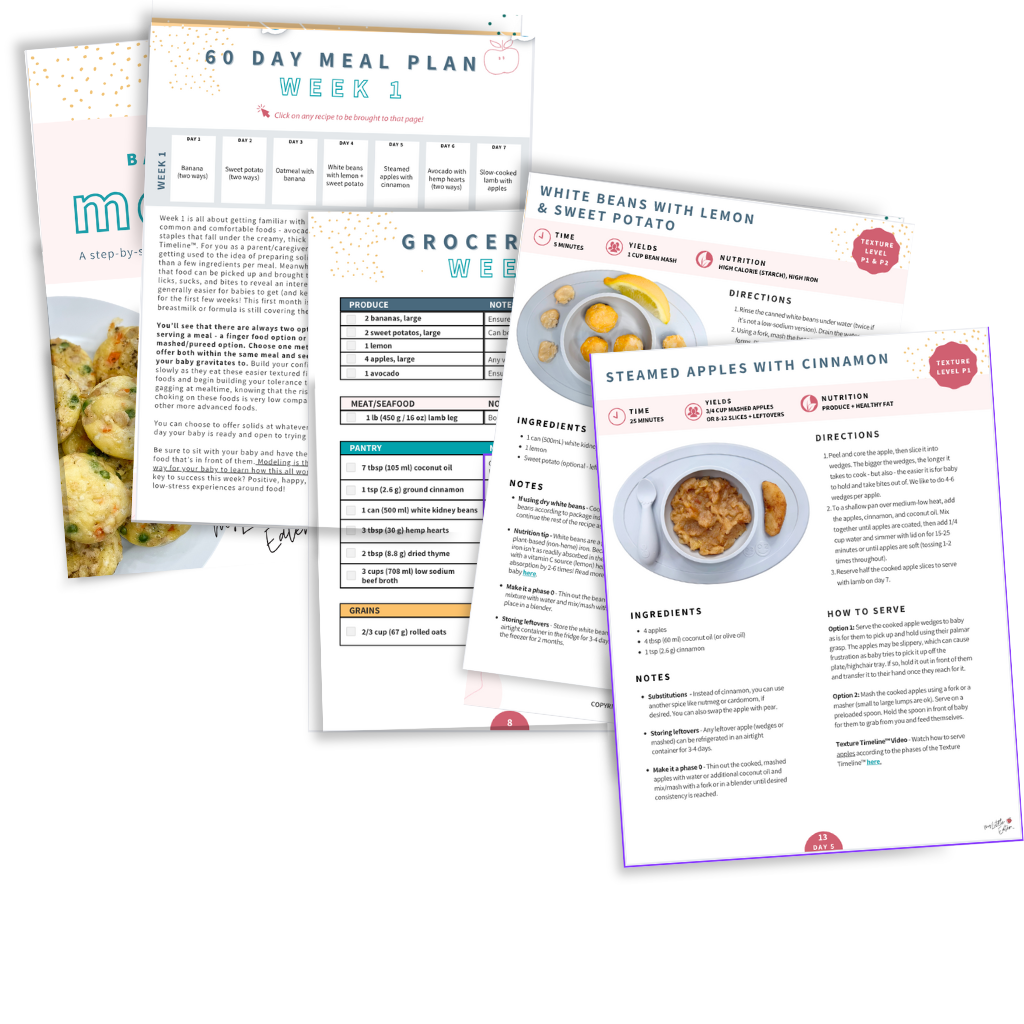
A lot of parents ask me… “Is there really anything I can do to prevent picky eating?” Maybe you’ve asked your doctor about it, and they told you that you can’t really do anything because it’s genetic. Or maybe they said…”All kids go through it. There’s nothing you can do about it”.
I’ve also had parents say to me… “My child is already picky – is it too late to help them? Will your toddler course still help me, or are we doomed forever?”
The answer to those questions are – yes, you can help prevent picky eating (or at least not make it as bad as it could be) and you can also reverse picky eating (at least to a point that you and your child won’t be stressed anymore and can live a normal life around food).
So first – let’s talk about preventing picky eating.
How to prevent picky eating
It’s natural for babies to approach 1+ year of age and enter a pickier stage of eating. This signals the end of what, I like to call, “The Honeymoon Phase”. In fact, the prevalence of picky eating ranges from 6% – over 70% of kids (mostly because there is no one clear definition of what picky eating is).
The fact of the matter is, the development of picky eating is affected by factors such as:
- pressure to eat
- personality factors
- parental practices/feeding styles
- social influences
- mealtime environment
- the introduction of complementary foods before 6 months
- the late introduction of chewy/textured foods
- the type of food exposed/frequency of exposures
… and many more.
Knowing that there is a lot of influence around the onset and severity of picky eating, you can start to take the right steps and act early to PREVENT it, instead of just reacting once it’s started.
This is 100% what I will always recommend, over and over again – prevention.
You see, prevention is a whole lot easier than reversing it. Why? Habits haven’t been engrained. You’re teaching them for the first time, just like the way you’ve taught them to speak. If you learn to speak with an accent, undoing it is way harder! Or, if you’ve learned a belief about yourself, or how to spell a certain word, or gotten in the habit of sleeping-in every morning, it’s really hard to break those habits. If they’ve been picky for 6 months, or 1 year, or 2 years, or more, you’re going to find that it gets harder and harder to reverse it.
Now, my advice is, once your baby is 10 months old, it’s best to start researching how to prevent picky eating. The easiest way would be to find an expert that you trust, and to follow their plan. We all know how many conflicting things we can find Googling on the internet!
Of course I’m going to recommend that you highly consider taking my Feeding Toddlers course around 10 months of age. I suggest this age because they’re usually close to, if not already, adopting the feeding schedule, and diet type, of a toddler. This is also when you might start to see some issues such as: wanting to exert independence over their food choices, beginning to push back and wanting some more control at mealtimes, and they may begin to show more preference over what foods they like and don’t like. Knowing how to respond at THIS point, is going to save you a lot of issues a few months down the road. Picky eating and anxiety around food can affect so many of their childhood years. They’re struggling, maybe it affects your relationship with your partner, and of course, I feel like this is a parent’s worst fear, it can compromise their health.
Keeping in mind too, that this is all assuming that you know what to do to treat picky eating. More often than not, many of us will try a tip from here, and a tip from there. Or we might turn to our moms for advice, maybe we try something that someone from a Facebook group suggested, etc. But the truth is that, if it’s not a) an evidence based strategy or b) if it’s done out of order from all of the other strategies for picky eating, it may not be effective. In fact, at best you could see no results, or at worst, you could possibly make things even worse. So, having a strategy and a holistic plan is the way to go.
Now, as mentioned, my Feeding Toddlers online course can help tackle picky eating before it starts, and sets your toddler up for the best eating habits. So make sure you check it out and get your hands on it now, if you’re at all interested. You have access to the course for life, so even if you’re not ready to start it now, you can always snag it at this price and keep it on deck for when you’re ready.
To add to all of this, and take it one step further, I also want to point out that earlier intervention (once they’re already picky) is better than “waiting to see” – aka later intervention. What often happens is we take our concerns up with our doctor, or our friends, or our family, and we may hear a familiar phrase… “It’s just a phase – wait it out and see if it will pass.”
…I hate that phrase!
More problems can develop when parents get the message that there’s nothing that can be done about picky eating, besides waiting it out. The amount of time (whether it be months or years) that they spend in the picky eating phase decreases significantly when you’re actively doing something about it. Those days, weeks, and months where it feels like “nothing’s happening, there’s barely any change, is this even worth it?” IS doing something – I promise! It’s preventing things from getting worse, and it’s ensuring that they WILL grow out of it. I can’t tell you how many messages I get from people saying that they’re still picky as adults, and it’s prevented them from trying things at restaurants, eating at dinner parties with friends, or getting healthier and expanding their diet to things that they know they need to eat for health reasons. ‘Cause, while most will grow out of it, some won’t if there’s no intervention happening and we’re just hoping that it will get better on its own. It doesn’t make sense to do this…it’s sort of like saying you’ll wait until you get heart disease, or cancer, to start taking care of your health. We ideally do not want that!!

Reversing Picky Eating
Is there really a way to reverse picky eating? When people ask “Is it too late to buy your course if my toddler is already picky?” – I say: “No! It’s never too late!” The thing is, getting help using a program like my course when things are already really bad, may just mean that instead of your child needing maybe 5-15 exposures of a food before they eat it, it might take 30-40+ times. It’s just going to take a lot more time to see changes happen. And yes, unfortunately, it can be a bit more stressful until you see results, but it doesn’t mean that you won’t see results. It just means that you’ll need to adjust your expectations! It’s only normal that if it took 6 months or a year for things to get to the point that it’s at now, that it may take 6 months or a year for things to get significantly better!
Now, what exactly does reversing picky eating mean? Remember that picky eating is a spectrum. So, it may be that your toddler eats most of the food you serve at home, but doesn’t like trying new food at restaurants, or ethnic flavours that they aren’t used to. It might also mean that your toddler eats 50 foods now instead of only 20 foods regularly. There’s still a bit of that genetic component to it, so just be clear in what your expectations are for a good result at the end. And usually, a good result means that you’re not stressed as a parent over your child’s eating anymore.
So, if you haven’t figured it out already from what I’ve just talked about, regarding my course helping to both prevent and reverse picky eating, it’s that the steps to prevent picky eating and the steps to reverse picky eating are the exact same. The difference is in the amount of time and effort that goes into it. This will depend highly on how picky they’ve become, and for how long it’s gone on for without help.
I want to dive a little bit more into what those steps are, and walk you through the phases of the course so you understand what the process for preventing and reversing picky eating looks like. We’re going to take a look at the first part of the course, which is all about HOW to feed your toddler. This is the part that tackles the picky eating, while the second part – the WHAT to feed your toddler, is more about the nutrition education you need to feed your toddler healthily.
If you prefer to listen, head over to my podcast episode where I walk you through this part of the course, explaining as I go. You can take a listen to the full episode here.
HOW to feed your toddler:
Step 1: Mastering your role in feeding
- This is where you learn about the importance of the effects of your interaction between you and your toddler, and about your specific feeding style.
- You’ll also learn about your role vs. your child’s role at mealtimes, and how to avoid mealtime battles, reduce stress, and foster a healthy eating environment.
- And finally, we run through some common scenarios and examples of how to stick within your feeding role.
The feeding relationship is one of the most important factors in how your toddler or preschooler eats. So, tackling this first and foremost, is a non-negotiable before moving onto the next few steps. There are also worksheets in this lesson to help you reflect on what your specific roles and styles are within your own family. This really helps you to take the time and apply the lesson to your own situation. It allows you to see any blind spots, or things you’ve never thought about or seen before, in your feeding relationship.
Step 2: How to set up a successful mealtime environment
The environment matters a lot! Toddlers are always learning new skills. Having structure and routine is very important in order for them to develop these skills and flourish. In addition to this, toddlers need to see the table as a fun and comfortable place to be at… they need to actually want to be there! So many times, parents tell me about the struggles to bring their toddlers to the table and keep them there at mealtime. This lesson will help you with that.
In this lesson, you’ll learn:
- How to set up a mealtime ritual for happy transitions to the table.
- How to properly seat your toddler for increased focus, comfort and ability to eat skillfully.
- The importance of family meals and how to make them work for you.
Step 3: How to serve meals
This lesson is golden because it takes you step-by-step through things that are often overlooked when feeding toddlers, and they actually make a world of difference to achieving successful meals.
In this lesson, you’ll learn:
- The benefits of family style meals (this is different than having a family sit down meal) vs. pre-plating food for picky toddlers.
- How meals can be served in a way to encourage mindful eating, expose your toddler to new food with reduced anxiety, and reduce overall food waste.
- What safe foods are, and how they help make every meal do-able.
Believe it or not, when I finally changed the logistics of how I served meals to my kids when they were toddlers, I saw HUGE changes in how much better they ate, and in overcoming their pickiness. So, this is a really great step that is not to be overlooked.
Step 4: What to say at mealtimes
I often hear from parents that they want to know exactly what to say to their toddlers when they ask us 101 questions. This can be especially difficult when we don’t want to influence how much, or if, they should eat. It can be complicated knowing how to influence them to try food without pressuring them.
So, in this lesson, you’ll learn:
- What to say and do at mealtimes to promote healthy eating and maintain gentle limits.
- What pressuring your toddler can look like and how to avoid it in all forms.
- Examples of scripts to use at the table and how to deal with one-off situations.
This lesson also has a great resource for you that summarizes the scripts we talk about, as well as another worksheet to go through to help identify areas where you may (or may not) be exerting pressure at mealtimes.
Step 5: The power of exposure
This is where, only after you’ve gotten the first 4 foundational lessons in place, you’ll be able to move on and start to really see some new progress happen. In this lesson, you’ll learn:
- To understand the true power in continuous exposure to food (and how many times it really takes!).
- How to use every feeding opportunity to expose your toddler to new food and bust out of your food rut.
- How to modify food at your toddler’s pace while still making progress
The resources in this lesson are so helpful, so make sure to download them! These tools will help ensure you’re always offering variety, and will help you plan out your meals in a way that will prevent, or get you and your toddler out of, that food rut!
Step 6: The power of food play
In this lesson, you’ll learn:
- The many steps that toddlers work their way through before they get to actually eating a food.
- The benefits of food play and bringing your toddler into the kitchen with you as a first step to eating.
- Food play activities that you can do with your toddler, both at and away from the dinner table, to overcome pickiness.
Step 7: The power of novelty
In this lesson, you’ll:
- Come to understand how novelty at mealtime helps to increase interest in the process of eating.
- Discover a range of simple novelty feeding tools and ideas you can use to entice your toddler to eat when things get just a little boring!
Basically, you’ll become a pro at this! You’ll have little tips and tricks that you can use with your toddler (who is now already used to the changes at mealtime, new foods, how things are run, etc.) to take their learning up a notch, so you can keep making good eating habits a thing!
Step 8: Managing sweet and desserts
This was a very highly requested lesson, and I decided to put it in this section of the course because how you approach desserts and sweets is such an important part in raising a mindful, healthy eater who – like we want – eats all sorts of food, including desserts! In this lesson, you’ll learn:
- How to position sweets and desserts to keep things both manageable and healthy.
- Tips on how to incorporate sweets and desserts to teach toddlers about the value of all food, as well as mindful eating.
- How to deal with well meaning grandparents, and how to keep treats feeling special.
So, those are the 8 steps I’ve outlined in my toddler course, and this is just the first half of the course! All of this is to be implemented sequentially, and practiced over and over, so you can prevent OR reverse picky eating. It saves you so much time and stress, can save your relationship with your child, and saves you money from having to go to feeding therapy if that’s the trajectory you were on. Plus, this course is available to you at home, to do at your own pace, and will help you to see real changes happen, so be sure to check that out!





